Home
> Scales
> Dominant
7th
This lesson will introduce you to eight key scales that you can connect to a dominant 7th backing chord. Each scale offers a unique flavour and colours the dominant seventh chord in different ways.
Start by watching the video below, which will get you playing these scales across the fretboard and encourage you to explore the different ways of colouring the dom7 chord in your solos. You can then find more tips and tracks to download further down the page.
For example, with the E7 track, the root of your scales will be E. With the A7 track, the root will be... yep, A!
Get your free online metronome here.
E string root pattern - ascending
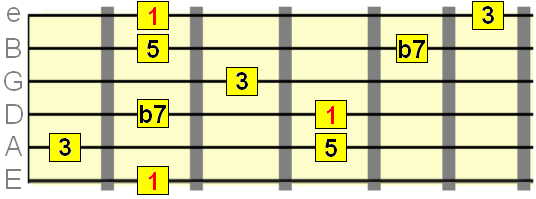
E string root pattern - descending
This pattern requires you to "roll" your index finger from the 1 on the G string to the 3 on the B string. For more on rolling, see the arpeggio technique lesson.
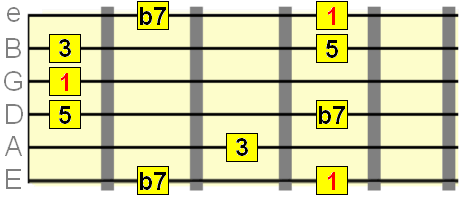
A string root pattern
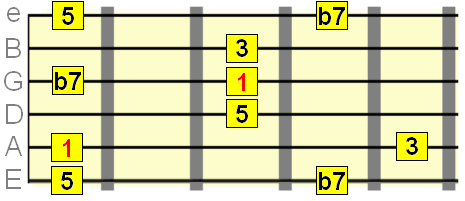
Tips
E string root pattern
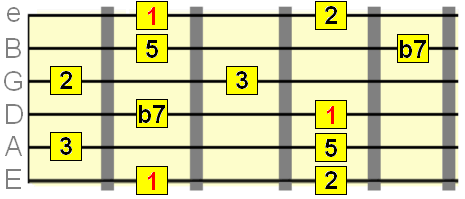
A string root pattern
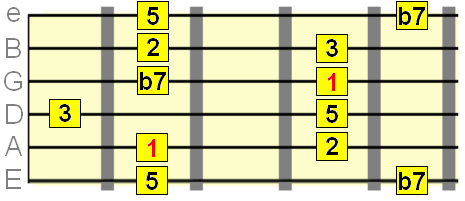
E string root pattern

A string root pattern
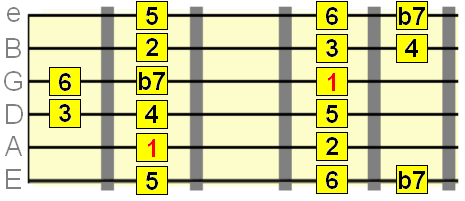
Tips
E string root pattern
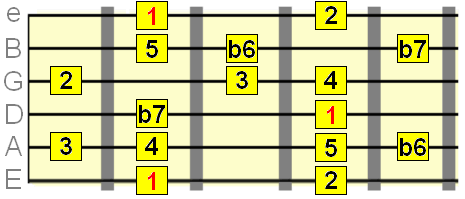
A string root pattern
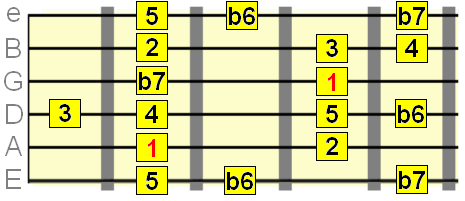
Tips
E string root pattern
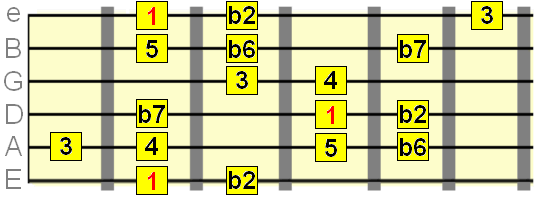
A string root pattern
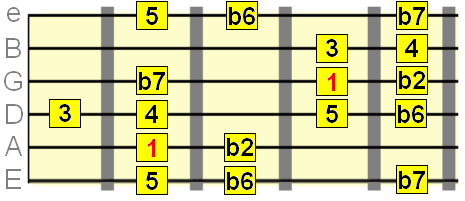
Tips
E string root pattern
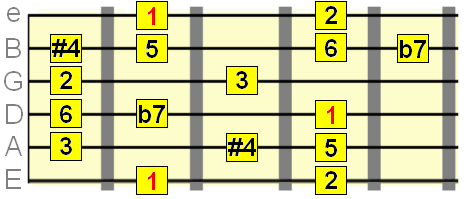
A string root pattern
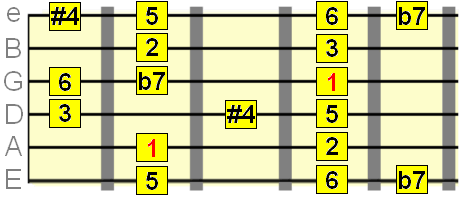
Tips
E string root pattern
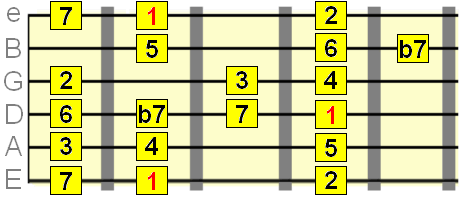
A string root pattern
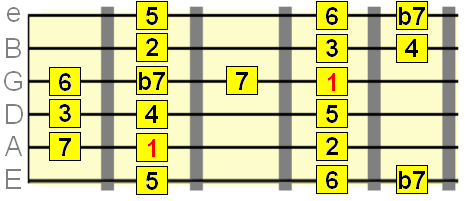
Tips
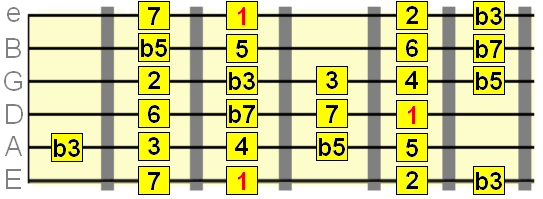
Tips
For example, it could be as simple as adding the 4th to the arpeggio to give the lick some voice leading (which tends to occur in semitone movements, such as between the 3rd and 4th)...
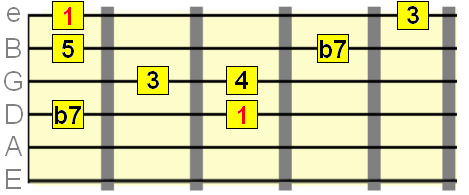
Suggested fingering in blue.
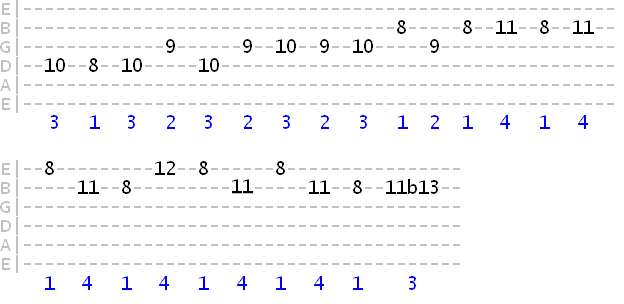
Another example, the lick below adds the major 2nd, augmented 4th, natural 4th and major 7th to the arpeggio giving us a dominant mish-mash of tones...
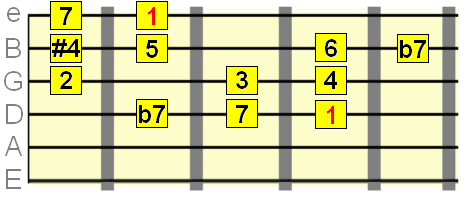

The more you practice combinations like this, the more you'll move away from "scale think" and towards pure "note selection think".
In other words, you'll start to see scales merely as convenient patterns of related intervals that you can interchange to create the expression you want.
But the chord tones (i.e. the arpeggio) will always be the tonal center of your phrases.
Soloing Over Dominant 7th Chords
Dominant seventh chords are used in most songs, so it's good to know your options for soloing over dominant 7th chords and the different ways you can colour them.This lesson will introduce you to eight key scales that you can connect to a dominant 7th backing chord. Each scale offers a unique flavour and colours the dominant seventh chord in different ways.
Start by watching the video below, which will get you playing these scales across the fretboard and encourage you to explore the different ways of colouring the dom7 chord in your solos. You can then find more tips and tracks to download further down the page.
Dominant seventh chord tracks
Use the chord tracks below to practice playing the scales in this lesson on different root positions.For example, with the E7 track, the root of your scales will be E. With the A7 track, the root will be... yep, A!
Get your free online metronome here.
- C7 track - download (right click and "save as")
- E7 track - download
- G7 track - download
- A7 track - download
Scale ideas for soloing over dominant 7th chords
So, here is a rundown of the scales covered in the video, with some tips for using them in a musical way...Dominant 7th Arpeggio
The most basic expression of the dominant 7th sound, using only the intervals of the chord - 1 3 5 b7E string root pattern - ascending

E string root pattern - descending
This pattern requires you to "roll" your index finger from the 1 on the G string to the 3 on the B string. For more on rolling, see the arpeggio technique lesson.

A string root pattern

Tips
- Build arpeggios around the chord shapes you know well. For example, the E and A form barre chords.
- Use arpeggios as part of larger scale phrases. Since all the scales on this page contain the dominant seventh arpeggio, you can use it as the "skeleton", adding in the colour tones (the "flesh") from the scales.
- You don't have to play all six strings. Try building repeating arpeggio phrases on just two or three strings.
- Since arpeggios only use chord tones, they are great for navigating through chord changes, especially if the time spent on the dom7 chord is short.
Dominant Pentatonic
A more suitable alternative to major pentatonic, since it contains the minor 7th (b7). However, regular major pentatonic will still work!E string root pattern

A string root pattern

Mixolydian (dominant scale)
The standard dominant scale choice.E string root pattern

A string root pattern

Tips
- The 4th is considered a non-chord tone, which means it's not part of the implied harmony of a dom7 chord, but it's still useful for filling out your phrases. Try resolving the 4th to the major 3rd or 5th target notes.
- You can find natural dominant 7th extensions within Mixolydian. Try adding the major 2nd and/or major 6th to the dom7 chord shapes using the patterns above.
Mixolydian b6
Simply flatten the 6th of Mixolydian for a bit more tension...E string root pattern

A string root pattern

Tips
- The minor 6th is a dissonant tone over dom7 chords. Use it in the same way as the 4th - in passing.
- Mixolydian b6 is the 5th mode of melodic minor. This means it works most naturally on the V chord of a minor key progression (e.g. Am - E7, Cm - F7, Em - B7). But in general, it works over the V chord of any key (major and minor).
- This scale also works nicely over augmented 7th chords (1 3 #5 b7), since the #5 and b6 are enharmonic (the same pitch).
Phrygian Dominant
Simply flatten the 2nd of Mixolydian b6 for an even more tense sound. Considered one of the more "exotic" scales to western ears.E string root pattern

A string root pattern

Tips
- The minor 2nd (b2) is a tension note and will sound dissonant over a dom7 chord of the same root. But dissonance isn't always bad! Try targeting the b2 if you want that tense, unresolved sound.
- Similar to Mixolydian b6, phrygian dominant works most naturally in a minor key, on the V chord. It gives that dominant chord a lot more tension before the resolution to a minor tonic. Incidentally, it's the 5th mode of harmonic minor (the harmonic minor scale starting from its 5th degree).
Lydian Dominant
Another nice alternative to Mixolydian, the only difference being an augmented 4th (#4) instead of a perfect 4th (4). Semi-interesting fact: Lydian dominant's "claim to fame" is The Simpsons theme tune.E string root pattern

A string root pattern

Tips
- The augmented 4th, although dissonant, can be held comfortably over a dominant seventh chord. In fact, it gives the chord a kind of ethereal quality. It's also versatile, as it will work over most instances of a dominant 7th chord.
- You can also play a pentatonic version of this scale using the following tones - 1 2 3 #4 b7 - great for short, quick runs that bring out the #4 colour.
Bebop Dominant
A jazzier dominant scale that adds a chromatic major 7th to Mixolydian...E string root pattern

A string root pattern

Tips
- The major 7th should be used as a bridge between the root and b7 in a phrase. By passing through it, you avoid emphasising the dischord of the major 7th against the minor 7th of the dominant seventh chord.
- Try quick slides up from the 7th to the root, or down to the b7 for a nice chromatic effect.
Blues Bebop
A combination of the bebop scale and the blues scale, which uses a b3 and b5 interval. This one will probably only be useful if you're going to be playing jazz, blues and their derivatives...
Tips
- As suggested in the video, because this is such a large scale (10 notes!) you'll have to use slides to accomodate the fingering. Where there is more than four notes on a string, use your index finger to slide between the notes left of the pattern.
- As the minor 3rd (b3) is a non-chord tone, try resolving it up to the major 3rd (3) for a famously bluesy sound.
- If the scale looks a bit overwhelming, try to visualise the dominant 7th chord shape within the pattern to establish those chord tone positions and get your bearings. Remember, the dom7 arpeggio exists in all the scales on this page.
Dominant 7th Note Selection
While it's fine to choose one scale for building your licks over dom7 chords, experiment with adding individual colour tones to the arpeggio.For example, it could be as simple as adding the 4th to the arpeggio to give the lick some voice leading (which tends to occur in semitone movements, such as between the 3rd and 4th)...

Suggested fingering in blue.

Another example, the lick below adds the major 2nd, augmented 4th, natural 4th and major 7th to the arpeggio giving us a dominant mish-mash of tones...


The more you practice combinations like this, the more you'll move away from "scale think" and towards pure "note selection think".
In other words, you'll start to see scales merely as convenient patterns of related intervals that you can interchange to create the expression you want.
But the chord tones (i.e. the arpeggio) will always be the tonal center of your phrases.
| |
Tweet |
Stay updated and learn more
Sign up to the newsletter for updates and grab your free Uncommon Chords book
Sign up to the newsletter for updates and grab your free Uncommon Chords book
More on Guitar Scales








